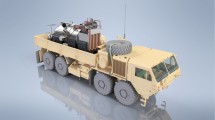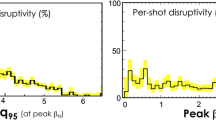Abstract
The dense Z-pinch (DZP) is one of the earliest and simplest plasma heating and confinement schemes. Recent experimental advances based on plasma initiation from hair-like (10s μm in radius) solid hydrogen filaments have so far not encountered the usually devastating MHD instabilities that plagued early DZP experimenters. These encouraging results along with the debut of a number of proof-of principle, high-current (1–2 MA in 10–100 ns) experiments have prompted consideration of the DZP as a pulsed source of DT fusion neutrons of sufficient strength (S N ⩾ 1019 n/s) to provide uncollided neutron fluxes in excess ofI w = 5–10 MW/m2 over test volumes of 10–30 liters or greater. While this neutron source would be pulsed (100s ns pulse widths, 10–100 Hz pulse rate), giving flux time compressions in the range 105–106, its simplicity, near-term feasibility, low cost, high-Q operation, and relevance to fusion systems thatmay provide a pulsed commercial end-product, e.g., inertial confinement or the DZP itself, together create the impetus for preliminary consideration as a neutron source for fusion nuclear technology and materials testings. The results of a preliminary parametric systems study (focusing primarily on physics issues), conceptual design, and cost vs. performance analyses are presented. The DZP promises an inexpensive and efficient means to provide pulsed DT neutrons at an average rate in excess of 1019 n/s, with neutron currents Iw≲10 MW/m2 over volumes Vexp ⩾ 30 liter using single-pulse technologies that differ little from those being used in present-day experiments.
Similar content being viewed by others
References
O. A. Anderson, W. R. Baker, S. A. Colgate, J. Ise, Jr., and R. V. Pyle (1958). Neutron production in linear deuterium pinches.Phys. Rev.,110(6), 1375.
J. Shiloh, A. Fisher, and E. Bar-Avraham (1979). “Interferometry of a gas-puff Z-pinch plasma.Appl. Phys. Lett.,35(5), 390.
N. R. Pereira, N. Rostoker, and J. S. Pearlman (1984). Z.-pinch instability with distributed current.J. Appl. Phys.,55(3), 704.
B. Kadomtsev (1966). Hydromagnetic stability of a plasma.Rev. Plasma Phys.,2, 153.
B. R. Suydam, Effect of the Gas Blanket on the Stability of the Dense Z-Pinch, Los Alamos National Laboratory Report LA-7809-MS, 1979.
W. C. Hartman, Finite Larmor Radius Stabilized Z-Pinches, Lawrence Livermore National Laboratory Report UCID-17118, 1976.
M. G. Haines (1981).Phil. Trans. Roy. Soc. Lond.,300A, 649.
D. W. Scudder (1985). Experiments on high-density Z pinches formed from solid deuterium fibers.Bull. Am. Phys. Soc.,30, 1408.
D. W. Scudder, R. Y. Dagazian, J. E. Hammel and P. R. Forman (1986). Solid deuterium fiber Z pinches: Experiment and theory.Bull. Am. Phys. Soc.,31, 1581.
J. D. Sethian, A. E. Robson, K. A. Gerber, and A. W. DeSilva (1987). Enhanced stability and neutron production in a dense Z-pinch plasma formed from a frozen deuterium fiber.Phys. Rev. Lett.,59(8), 892.
R. A. Nebel, H. R. Lewis, J. E. Hammel, D. W. Scudder, and P. Rosenau, 1-D transport calculations for Z-pinch fibers (to be published).
R. A. Nebel, H. R. Lewis, I. R. Lindemuth, R. A. Nebel, and P. Rosenau (1987). Multidimensional MHD simulations of dense Z-pinch fibers.Bull. Am. Phys. Soc.,32(9), 1758.
A. H. Glasser (1989). Z-pinch and plasma focus: Report on the 1988 workshop on Z-pinch and plasma focus, Nice, France, October 10–11, 1988.Nucl. Fusion,29, 129.
N. R. Pereiva, J. Davis, and N. Rostoker (eds.), Proc. 2nd International Conf. on dense Z-pinches, Laguna Beach, California, April 26–28, 1989. AIP Conf. Proceedings,195 (1989).
M. A. Abdou, Modeling, Analysis, and Experiment for Fusion Nuclear Technology, University of California at Los Angeles Report PPG-1021, January 1987.
R. Hagenson, J. Hammel, R. Krakowski, R. Miller, R. Nebel, D. Scudder, and K. Werley (1987). The high-density Z-pinch (HDZP) as a fusion neutron source.Proc. 12th IEEE Symposium Fusion Engineering,2, 835.
R. W. Moir and R. S. Frost, eds., Study of a Magnetic Fusion Production Reactor, Lawrence Livermore National Laboratory Report UCRL-94408, 1980.
C. W. Hartman, G. Carlson, M. Hoffman, R. Werner, and D. Y. Cheng (1977). A conceptual fusion reactor based on the high-plasma-density Z-pinch.Nucl. Fusion 17(5), 909.
R. L. Hagenson, A. S. Tai, R. A. Krakowski, and R. W. Moses (1981). The dense Z-pinch (DZP) as a fusion power plant: Preliminary scaling calculations and systems energy balance.Nucl. Fusion,21(11), 1351.
M. G. Haines and S. P. Walker (1987). Compact fusion reactors: The potential of the dense Z-pinch.Nucl. Energy.
R. L. Hagenson, A. S. Tai, R. A. Krakowski, and R. W. Moses, The Dense Z-Pinch (DZP) as a Fusion Power Reactor: Preliminary Scaling Calculations and Systems Energy Balance, Los Alamos Scientific Laboratory Report LA-8186-MS, 1980.
R. S. Pease (1957). Equilibrium characteristics of a pinched gas discharge cooled by bremsstrahlung radiation.Proc. Phys. Soc.,70B, 11.
S. Glasstone and R. H. Lovberg (1960).Controlled Thermonuclear Reactions (Van Nostrand Reinhold, New York), p. 226.
R. A. Krakowski, Fusion Burn Dynamics in Dense Z-Pinch (DZP), Los Alamos National Laboratory Report LA-11757-MS (December, 1989).
R. L. Hagenson et al., Compact Reversed-Field Pinch Reactors (CRFPR): Preliminary Engineering Consideration, Los Alamos National Laboratory Report LA-10200-MS, 1984.
R. H. Lovberg, Retention of DT Alpha Particles in the Dense Z-Pinch, Los Alamos National Laboratory, April 1989 (personal communication).
I. R. Lindemuth, G. H. McCall, and R. A. Nebel (1989). Fiber ablation in the solid-deuterium Z pinch.Phys. Rev. Lett,62(3), 264.
J. C. Martin and I. D. Smith (1965).Pulsed-Power Notes (Atomic Weapons Research Estab., Aldermaston, U.K.).
C. G. Bathke, R. A. Krakowski, R. L. Miller, and K. A. Werley (1989). The Reversed-Field-Pinch (RFP) Fusion Neutron Source: A Conceptual Design.J. Fusion Energy 8(3–4), 249.
A. F. Robson (1989). “The Dense Z-Pinch as a Small Fusion Reactor,”AIP Conf. Proc. 195, 362.
Los Alamos Monte Carlo Group, MCNP-A General Monte Carlo Code for Neutron and Photon Transport, Los Alamos National Laboratory Report LA-6396-MS, revised, April, 1981.
N. M. Ghoniem and G. L. Kulcinski (1980). A critical assessment of the effects of pulsed irradiation on the microstructure swelling, and creep of materials.Nucl. Tech. Fusion,2(2), 165.
E. P. Simonen, N. M. Ghoniem, and N. H. Packan, (1984). Pulsed flux effects on radiation damage.J. Nucl. Mater.,122/123, 391.
G. L. Kulcinski and M. E. Sawan (1985). Differences between neutron damage in inertial and magnetic confinement fusion test facilities.J. Nucl. Mater.,133/134, 52.
J. Shannon, 2nd IEEE Int. Pulsed Power Conf., Lubbock, Texas, June 12–14, 1979, p. 226.
Author information
Authors and Affiliations
Additional information
Work supported by U.S. DOE.
Rights and permissions
About this article
Cite this article
Krakowski, R.A., Sethian, J.D. & Hagenson, R.L. The high-density Z-pinch as a pulsed fusion neutron source for fusion nuclear technology and materials testing. J Fusion Energ 8, 269–286 (1989). https://doi.org/10.1007/BF01051654
Issue Date:
DOI: https://doi.org/10.1007/BF01051654




